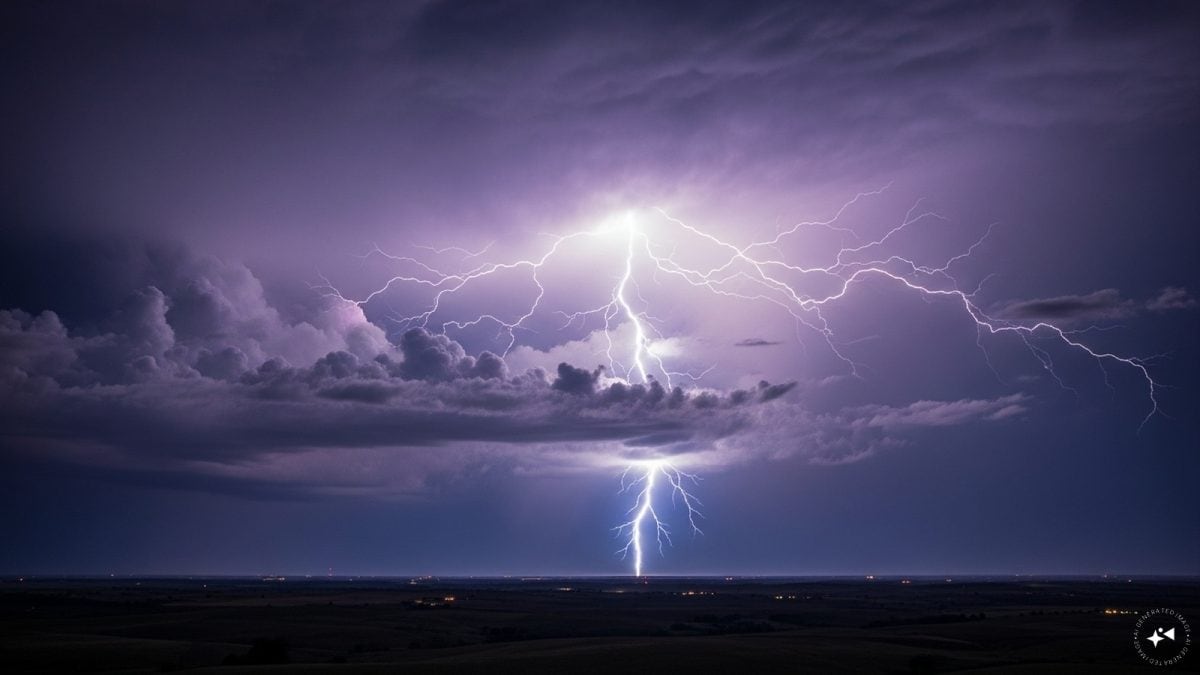- July 31, 2025
Texas To Kansas Lightning Bolt Confirmed As World’s Longest Ever At 829 Kilometres

Last Updated:
The world’s longest lightning bolt, stretching 829 km across the Great Plains, was confirmed by the WMO.
Record-breaking megaflash captured in concept: A single bolt of lightning stretches from Texas to Kansas, showcasing nature’s astonishing scale and power. (IMAGE: IMAGEN 4 ENGINE)
A massive lightning strike that lit up the skies from Texas to Kansas has been confirmed as the world’s longest lightning bolt ever recorded, stretching an astonishing 829 kilometres across the Great Plains. The strike occurred in October 2017 but was only recently confirmed, the World Meteorological Organisation (WMO) said on Thursday.
The bolt, classified as a “megaflash,” beat the previous record of 768 kilometres by a significant 61-kilometre margin. The previous record-holder flashed across Texas, Louisiana, and Mississippi in April 2020.
Unlike regular lightning, megaflashes stretch horizontally across clouds, often over hundreds of kilometres. Scientists say they are still learning about how these rare phenomena occur. “We’re just now figuring out the mechanics of how and why it occurs,” said Randy Cerveny of Arizona State University, who also works with the WMO. “It is likely that even greater extremes still exist, and that we will be able to observe them as additional high-quality lightning measurements accumulate over time.”
The discovery was made using satellite data from NOAA’s GOES East weather satellite, which orbits over 35,000 kilometres above the Earth’s surface. This high-altitude vantage point allows researchers to capture massive lightning events that ground-based detection systems often miss.
Typically, most lightning bolts are less than 16 kilometres long and strike vertically. But when conditions allow, some stretch horizontally for hundreds of kilometres inside thundercloud systems and that’s when megaflashes are born. Scientists classify any lightning bolt longer than 100 kilometres as a megaflash.
The WMO said the new record highlights not only the raw power of nature, but also advances in lightning tracking technology that allow researchers to map and confirm such rare events.
Lightning is caused by the build-up and discharge of electrical energy in storm clouds. As particles within the cloud collide, they create a separation of charges where positive charges rise to the top and negative sink to the bottom. When the imbalance becomes too great, electricity surges through the air in a sudden flash. This raw, powerful force of nature has fascinated humans for centuries, symbolising both fear and awe. Beyond its visual drama, lightning helps maintain Earth’s electrical balance and contributes to nitrogen fixation in the soil, which is essential for plant life and a reminder of its hidden ecological role.

Shankhyaneel Sarkar is a senior subeditor at News18. He covers international affairs, where he focuses on breaking news to in-depth analyses. He has over five years of experience during which he has covered sev…Read More
Shankhyaneel Sarkar is a senior subeditor at News18. He covers international affairs, where he focuses on breaking news to in-depth analyses. He has over five years of experience during which he has covered sev… Read More
view comments
- First Published:
Read More






